
1959
In the Belgian Congo, a man visits a Kinshasa clinic suffering from joint pain and fatigue. Some 40 years later, tests of the patient’s blood samples, saved by his doctor, will reveal HIV.
1980
October 31
French-Canadian flight attendant Gaetan Dugas pays his first known visit to New York City bathhouses. All of the city’s early infections would be traced to Dugas, since dubbed “Patient Zero.”
November 1
A young gay man named Nick suffers a seizure and loses consciousness. His boyfriend, Enno Poersch, rushes him to St. Luke’s-Roosevelt, where he’s diagnosed with toxoplasmosis, a disease usually found in cats. “I had no idea it was the beginning of an epidemic,” recalls his doctor, Michael Lange.
New AIDS cases in NYC: 52.
Deaths so far: 15.
1981
January 15
Nick dies. Doctors are puzzled by an outbreak of the rare skin cancer Kaposi’s sarcoma. “We had twenty cases in the city,” recalls Dr. Alvin Friedman-Kien. “All used poppers, amyl nitrate. We suspected it could be that.” (Later theories would blame contaminated polio vaccines, other recreational drugs, and even biowarfare.)
May 18
Lawrence Mass, a gay doctor, publishes the first story on the illness in the gay weekly New York Native: disease rumors largely unfounded.
June 5
The Centers for Disease Control (CDC) reports on a cluster of Pneumocystis pneumonia, a deadly pulmonary infection, among gay men in Los Angeles.
July 3
The New York Times’ first headline: RARE CANCER SEEN IN 41 HOMOSEXUALS.
August 11
Larry Kramer, whose 1978 novel Faggots took gay men to task for loveless promiscuity in pre-AIDS New York, calls a meeting of concerned men in his Village apartment.
September 7
Kramer and two friends put up a banner at the Fire Island dock that says give to gay cancer. They make only $124.
December 21
Time and Newsweek run their first major stories.
December
ABC’s Good Morning America is the first network show to cover the disease, in a nine-minute segment cut down to 150 seconds owing to a report on unrest in Lebanon. Frank Gifford begins by saying, “This is a terrible problem. How come nobody’s paying any attention to it?”
New AIDS cases in NYC: 162.
Deaths so far: 74.
1982
January 12
Gay Men’s Health Crisis (GMHC) is founded by six men, including Kramer—but he walks out eight months later, telling the Times, “Everything, everything, is too little, too late. By our silence we have helped murder each other.”
January
“Gay-related immune deficiency” (GRID) gains currency, though the name becomes obsolete when straight Haitians show up with symptoms in Brooklyn hospitals. (Hemophiliacs would soon join them in the public’s mind as the third H group seen to be at any real risk.)
April 8
GMHC’s fund-raiser at the fun-sleazy dance club Paradise Garage raises $50,000.
July 27
The disease is renamed AIDS (acquired immunodeficiency syndrome).
December 10
Panic over the nation’s blood supply sets in after a baby in California becomes sick following blood transfusions. (A donor is later discovered to have AIDS.)
December
Dr. Arye Rubinstein submits a study to the American Academy of Pediatrics finding evidence of AIDS among five infants in the Bronx. It’s rejected—based on the belief that the disease is confined to gay men.
New AIDS cases in NYC: 543.
AIDS deaths so far: 276.
1983
March 7
Kramer publishes “1,112 and Counting” in the Native. He begins, “If this article doesn’t rouse you to anger, fury, rage and action, gay men may have no future on this earth.”
April 20
Mayor Ed Koch holds his first meeting with gay-community reps, t agreeing to proclaim the last week of April “Aid AIDS Week”—and little else. “Gays did not have a seat at the political table in those days,” recalls longtime activist Bill Dobbs. “And so the anger over the way Koch and others treated us sparked a stunning activist movement.”
April 30
GMHC fund-raiser at Madison Square Garden fills the 17,000-seat arena.

May
Safe sex is born: Activist and writer Michael Callen’s pamphlet, How to Have Sex in an Epidemic: One Approach, urges condom use. He dies in December 1993.
June 3
Dr. Luc Montagnier of the Pasteur Institute in Paris tells colleagues he has isolated the retrovirus that causes AIDS. He calls it LAV (lymphadenopathy-associated virus).
June 13
Tabloid panic: The New York Post’s front page reads L.I. GRANDMA DIED OF AIDS. The next day’s story inspires more fear still: JUNKIE AIDS VICTIM WAS HOUSEKEEPER AT BELLEVUE.
June 18
The state Funeral Directors Association urges members not to embalm AIDS fatalities.
June 20
New York Magazine’s cover story on “AIDS Anxiety” reads, “AIDS victims have been fired from their jobs, driven from their homes, and deserted by their loved ones. Any homosexual or Haitian has become an object of dread … ”

June
Patrick Buchanan calls on Mayor Koch to cancel the Gay Pride Parade as a health threat. Koch orders extra cops to protect marchers.
August 6
Club fixture Klaus Nomi is among the first downtown celebrities to die.
September 30
New York State sues a West 12th Street co-op for trying to evict Dr. Joseph Sonnabend for treating AIDS patients. He later receives $10,000 and a new lease.
December 31
The city has spent a total of $24,500 on AIDS since the crisis started.
New AIDS cases in NYC: 1,096.
Deaths so far: 864.
1984
January 12
The State Health Department urges dentists to wear gowns, masks, rubber gloves, and eye goggles.
April 23
Failing to give the French credit, U.S. Health and Human Services secretary Margaret Heckler announces that Dr. Robert Gallo of the National Cancer Institute has isolated the virus that causes AIDS. It is named HTLV-III.
Late 1984
Tests for the virus are newly available, and novelist Edmund White gets one with his lover. “I’ll be positive, you’ll be negative, and within six months you will have broken up with me,” he recalls telling his partner. “That’s what happened.” In 1997, White will publish The Farewell Symphony, about outliving friends.
New AIDS cases in NYC: 1,841.
Deaths so far: 1,960.
1985
March 10
The first big season for plays about AIDS: William M. Hoffman’s As Is premieres, followed on April 21 by Larry Kramer’s The Normal Heart.
July 25
Amid a flurry of rumors, Rock Hudson’s spokesman reveals that the actor has AIDS.
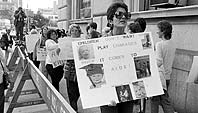
September 9
Queens parents launch a school boycott after the city allows a second-grader with AIDS to attend classes.
September 19
AIDS fund-raising becomes a cause celeb: Dr. Mathilde Krim, grande (and very influential) dame of the American Foundation for AIDS Research, co-hosts the first Hollywood benefit with Elizabeth Taylor. Rod Stewart and Bette Midler attend.
October 2
Rock Hudson dies, after his rapid decline becomes a nationally televised spectacle.
October 5
To ease paranoia over AIDS in schools, the chancellor says all classrooms will stock alcohol-dipped cotton swabs.
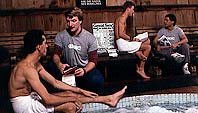
October 25
Against Koch’s recommendation, New York State urges local health officials to padlock gay baths and sex clubs. A month later the Mine Shaft is shuttered, followed by Plato’s Retreat, a straight swingers’ club.
December
The Gay & Lesbian Alliance Against Defamation holds its first protest, targeting the Post for its AIDS coverage.
December 15
In a poll, 37 percent of Americans have a “less favorable” attitude toward gays since AIDS. Only 2 percent were more sympathetic.
New AIDS cases in NYC: 2,871.
Deaths so far: 3,766.
1986
March
The birth of a legendary logo: silence = death stickers begin popping up. “We were very conscious of making it ‘yuppie graphics,’ ” recalls Avram Finkelstein, a member of the anonymous collective that created it. “We were using Gill Sans Serif. At the time, that was the typeface.”
April 19
The International Committee on the Taxonomy of Viruses rules that the AIDS-causing virus should be called human immunodeficiency virus (HIV).
July 4
During the rededication of the Statue of Liberty, Bob Hope jokes, “I just heard the Statue of Liberty has AIDS. Nobody knows if she got it from the mouth of the Hudson or the Staten Island Fairy.”
May 20
At GMHC’s first AIDS Walk in New York, 4,500-plus participants raise $710,000.
August 2
Roy Cohn dies of AIDS, asserting to the last that he has liver cancer.
September 29
Early results show that the drug AZT can slow down progress of HIV. Jubilation breaks out—prematurely. “After six years of having nothing to do for people but hold their hands and watch them die, I got my patients on it ASAP,” recalls Dr. Howard Grossman. “We didn’t know that AZT on its own is only good for six months before resistance sets in.”
New AIDS cases in NYC: 4,217.
Deaths so far: 6,458.
1987
February 4
Liberace dies.
March 19
The FDA approves AZT as the first antiretroviral drug for AIDS. But at $12,000 a year, it’s one of the costliest drugs in history.
March 24
A new phase of activism: The first ACT UP demonstration protests the FDA’s slow speed in approving AIDS drugs, which could take nine years. Traffic is stopped, demonstrators are arrested, and an effigy of the FDA head—provided by the Public Theater’s Joe Papp—is burned. Soon after, the FDA says it will cut two years off the process.
May 31
President Reagan first mentions AIDS, six and a half years into his presidency.
June 2
Mayor Koch calls for mandatory HIV testing for visitors and immigrants to the U.S. Those with HIV should be denied entry, he says.
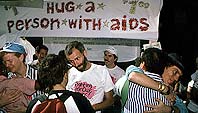
July 2
Michael Bennett, creator of A Chorus Line, dies. “AIDS set the theater back 40 years in terms of wiping out a whole layer of creativity,” says Charles Kaiser, author of The Gay Metropolis, a history of gay life in the city.
October
Equity Fights AIDS is founded and merges with Broadway Cares five years later. The group has since raised more than $100 million.
New AIDS cases in NYC: 5,216.
Deaths so far: 9,756.
1988
January
DC Comics introduces Extraño, a gay superhero who contracts HIV after he’s bitten by the villain Hemo-Goblin.
January
Cosmo says women can have unprotected sex with an HIV-positive man without fear. “Most heterosexuals are not at risk,” the magazine says, adding that it’s impossible to transmit HIV in the “missionary position.”
May 26
At Surgeon General C. Everett Koop’s insistence, the CDC mails out 107 million copies of the brochure “Understanding AIDS.”
September 15
ACT UP protests MoMA’s show of graphic photos of people with AIDS by celebrated photographer Nicholas Nixon, who was neither gay nor afflicted. “The artist makes people with AIDS look like freaks, like sickly, helpless ‘victims,’ in the most fatalistic sense of the word,” Michael Kimmelman writes in the Times.
November 7
To stem the epidemic among IV drug users—who will dominate new AIDS cases over the next decade— the city approves a hypodermic needle exchange in the downtown headquarters of the Health Department. Users are admitted only upon agreeing to seek treatment. (The program would close in 1990.)
New AIDS cases in NYC: 6,445.
Deaths so far: 13,990.
1989
March 9
Robert Mapplethorpe dies.
March 11
AIDS on Park Avenue: The Times runs a story about Alison Gertz, 23, an Upper East Sider. “They tested her for everything,” says her mother. “But they never tested her for AIDS because nobody thought a heterosexual woman who’s not a drug user would get it. We subsequently learned that she’d gotten it from a good friend, who she’d only slept with once.” She dies in 1992.
May 10
The fashion world gets involved: Susanne Bartsch hosts the Love Ball at Roseland, which raises more than $300,000 for Design Industries Foundation Fighting AIDS (DIFFA).
August 10
Keith Haring reveals he has HIV. Prices for his art soar as collectors anticipate his death (in 1990).
August 18
More promising AZT news causes stock in manufacturer Burroughs Wellcome to jump 32 percent.
September 14
Seven ACT UP members infiltrate the Stock Exchange and chain themselves to the VIP balcony. Above the trading floor a banner unfurls: SELL WELLCOME. Four days later, the company lowers the price of AZT, to $6,400 per year.
December 1
Alvin Ailey dies.
December 10
Public opinion begins to turn against ACT UP after the St. Patrick’s Cathedral demonstration, where one protester snapped a communion wafer and tossed it at Cardinal John O’Connor.
New AIDS cases in NYC: 6,871.
Deaths so far: 19,241.
1990
May
New Yorkers meet Marisol and Julio, two Latino lovers grappling with sex in the age of AIDS—in an ongoing comic strip plastered in subways.
May 11
Longtime Companion, the first feature film about AIDS, is released. During shooting, a key actor, Peter Evans, dies of AIDS, and director Norman Rene tests positive. The lover of writer Craig Lucas helps Rene fudge insurance forms so he won’t get fired.
August 18
Congress passes the Ryan White CARE Act, a five-year emergency-relief fund named for the hemophiliac teenager with AIDS, from Indiana, who died in April.
New AIDS cases in NYC: 7,752.
Deaths so far: 24,835.
1991
February 27
The New York City Board of Education votes to make condoms available in high schools, sparking an outcry among religious conservatives. Three years later, the tide turns and condoms are no longer offered.
June 2
At the Tony Awards, Jeremy Irons debuts the red ribbon.
August 8
Tom Duane, an openly gay candidate in a close race for a West Side City Council seat, reveals he has HIV after opponent Liz Abzug comes out as a lesbian. Duane says he’s not on medication, has no symptoms, rises at 6:30 a.m., and rarely goes to bed before midnight, living on “stress and coffee—the candidate’s best friend.” In November, he becomes the first openly HIV-positive candidate in the country to win public office.
November 7
Magic Johnson announces he’s HIV-positive and decides to retire from basketball.
New AIDS cases in NYC: 9,072.
Deaths so far: 31,202.
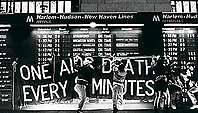
1992
January
ACT UP’s brain trust abandons street tactics to form Treatment Action Group, aimed at overhauling federal AIDS research. With backing from major donors and researchers, the group will become a force in national AIDS policy.
April 9
Mayor David Dinkins names Ronald Johnson of the Minority Task Force on AIDS as the first citywide coordinator of AIDS policy. Johnson’s now at GMHC.
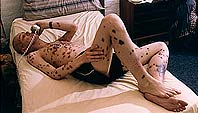
May
Billboards by artist Felix Gonzales-Torres go up around the city. His photos, taken shortly after his lover died, depict an empty bed.
July 22
Artist David Wojnarowicz dies.
November 3
Election of Bill Clinton, who’d promised a cabinet-level AIDS czar and a Manhattan Project to find a cure. Neither happened, though once out of office, Clinton would join Nelson Mandela in the global fight against AIDS.
New AIDS cases in NYC: 10,871.
AIDS deaths so far: 38,044.
1993
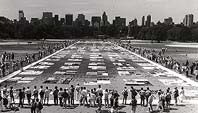
February 6
Death of tennis star Arthur Ashe, who contracted HIV through a blood transfusion.
Early 1993
West Side Club bathhouse opens a few blocks away from GMHC.
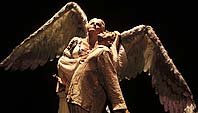
May 4
Tony Kushner’s Angels in America opens on Broadway. Along with its sequel, Perestroika, it’s been canonized as the best piece of theater on the epidemic and perhaps the first whose main character survives the end of the play.
December 23
The film Philadelphia premieres; Tom Hanks goes on to win an Oscar.
New AIDS cases in NYC: 12,661.
Deaths so far: 45,110.

1994
June
After GMHC debuts its “Young, Hot, and Safe” subway ads, the right strikes back, with the Catholic League unveiling its own campaign: “Want to know a dirty little secret? Condoms don’t save lives.”
August 18
Playboy playmate Rebekka Armstrong announces that she has AIDS on Entertainment Tonight.
1995
January 30
AIDS is now the leading cause of death among all Americans ages 25 to 44, the CDC announces.
March 5
Pernessa Seele, founder of the Harlem-based group Balm in Gilead, launches the first AIDS mobilization in black churches. Six years later, Gilead’s Week of Prayer for the Healing of AIDS, which includes education and an emphasis on compassionate ministry, gets CDC funding to expand nationwide. Now churches across America, the Caribbean, and Africa participate each Lent.
August 9
David Geffen gives $4 million (the biggest solo AIDS donation yet) to GMHC and God’s Love We Deliver, which brings meals to people with AIDS.
December 7
The FDA approves saquinavir, the first in a powerful new class of HIV drugs called protease inhibitors. Soon followed by cousins ritonavir and indinavir, the drugs are hailed as the most promising development in AIDS history.
1996
April 29
Rent, Jonathan Larson’s snapshot of life in the pre-protease-inhibitor East Village, opens on Broadway to huge success.
July 7
At the World AIDS Conference in Vancouver, Dr. David Ho, who pioneered the protease-inhibitor studies that would make him Time’s Man of the Year, announces to a standing-room crowd of fellow researchers, advocates, journalists, and stock analysts that protease inhibitors present “the possibility that HIV will be completely eradicated from the body.” While that hope soon vanishes, the drugs usher in a new era: AIDS as a chronic, manageable illness. Before long, people with advanced AIDS are climbing out of their sickbeds and resuming normal lives, a phenomenon that comes to be known as Lazarus Syndrome. Cover stories hailing the “end” of the epidemic appear in The New York Times Magazine, The Wall Street Journal, and Newsweek.
New AIDS cases in NYC, 1994 to 1996: 33,208.
Deaths so far: 67,049.
1997
May 5
Tabloid super-star Andrew Cunanan—gigolo, drag queen, meth addict, “AIDS revenge” serial killer—stops by the West Side Club on his way to killing Versace and then himself.
September 13
The new Miss America, Kate Shindle, vows to dedicate her term to youth HIV prevention. When schools rein her in, she later tells Poz magazine, “Sometimes I feel like I’m banging my head against the wall.”
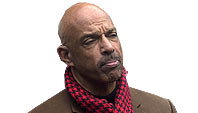
November 4
Openly positive Phil Reed elected to City Council from Harlem.
1998
June 3
Feds green-light the first human tests of an AIDS vaccine, including a trial of gay men in New York. Called AIDSVAX, the vaccine is widely viewed as unpromising, but it is safe, and so gets the nod from officials under attack for foot-dragging. Five years and 5,400 earnest volunteers later, AIDSVAX is declared a dud.
June 19
Following tabloid outcry over serial infector Nushawn “The One Man Epidemic” Williams, New York State unexpectedly passes what appears to be one of the nation’s harshest HIV-testing laws, calling for partner notification for everyone who tests positive. AIDS activists’ disbelief turns to relief, though, when legislators later realize the law would not force any person with HIV to name names.
July 7
The Times reports on a strange side effect of some HIV drugs known as lipodystrophy: “While fat disappears from some areas, for unknown reasons it redistributes to build up in others. The back of the neck resembles a buffalo hump. Breasts enlarge. A woman may have to buy a bra that is two sizes larger than the last one.”

September
Playwright Sarah Schulman rages against the commodification of AIDS-related art in Stagestruck: Theater, AIDS, and the Marketing of Gay America.
New AIDS cases in NYC, 1997 and 1998: 13,060.
Deaths so far: 73,070.
1999
February 1
Scientists trace HIV to a virus in chimpanzees, first spread to humans through chimp bites and exposure to chimp blood during hunting.
February
Poz publishes a cover story on “Boys Who Bareback,” about the rise of condomless sex among gay men.
February 16
In a city Health Department sex survey, 18 percent of young black men who admit to having sex with other men are infected with HIV (compared with 3 percent of white respondents). That rate would double in two years, around the time that the slang term down low—for black men who have sex with men but don’t identify as gay—goes mainstream. “When white businessmen have sex with other men, they’re in this nice quiet thing called the closet,” says Phil Reed. “But when it’s black men, we’ve got to stigmatize them and put it on Oprah.”
New AIDS cases in NYC: 5,337.
Deaths so far: 75,800.
2000
For the first time in a decade, male-to-male sexual transmission overtakes IV drug use as the leading cause of AIDS. Researchers will soon see the results of the “instant bottom” effect of Tina, or crystal methamphetamine. Studies say that somewhere between 10 and 20 percent of gay men in New York City are using the drug, which impairs decision-making about safe sex. “A sober barebacker is far less risky than a meth barebacker, who will have sex for days on end with multiple partners,” says longtime activist Peter Staley. “And the sex is rougher. There is more tissue damage.”
October 20
A federal judge in Brooklyn rules that the City Division of AIDS Services has “chronically and systematically” failed to provide services, including emergency housing, rent assistance, food stamps, and Medicaid to 25,000 New Yorkers with AIDS.
2001
December 21
Larry Kramer survives a lifesaving liver transplant. While he’s in surgery, bloggers erroneously report the 70-year-old is dead.
2004
March 26
FDA approves the first saliva rapid HIV test.
December 1
The CDC reports that African-Americans account for 51 percent of all new HIV infections in 32 states, but make up only 13 percent of the population in those states.
2005
January 3
The Aaron Diamond AIDS Research Center begins recruiting volunteers for a clinical trial of an experimental vaccine, ADMVA, to prevent HIV infection.
December 19
“Taking a T.” An HIV drug comes out of the medicine cabinet. Whether sold in packets with Viagra and Ecstasy or prescribed by docs, tenofovir is increasingly being used by HIV-negative gay partyers in lieu of condoms, though there’s no proof it works.
February 11
A new supervirus? City Health commissioner Dr. Thomas Frieden announces that a promiscuous gay crystal-meth user has been diagnosed with fast-progressing, triple-drug-resistant HIV. But when no more cases turn up—except as jokes on Saturday Night Live (“¡SIDA fantástico!”)—Frieden backs away from the theory. The patient has since returned to work.
September
Theater begins catching up with the worldwide pandemic with In the Continuum, a play at the Perry Street Theater, about two black women with HIV—one from Zimbabwe, one from L.A.
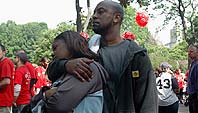
2006
May 20
The e-invitation for a condom-free sex party in Harlem—the night before GMHC’s 21st annual AIDS Walk—includes this rule: “Anyone caught using jimmies will be asked to leave with no refund given!!”
June 5
AIDS groups mark 25-year anniversary of the CDC’s first report on the AIDS virus, which has since killed 25 million worldwide and now infects 40 million.
RELATED STORY
The Coming Out
of Regan Hofmann
White, single, and from Princeton, she was terrified to tell anyone she had HIV. Until she announced it on the cover of a magazine.